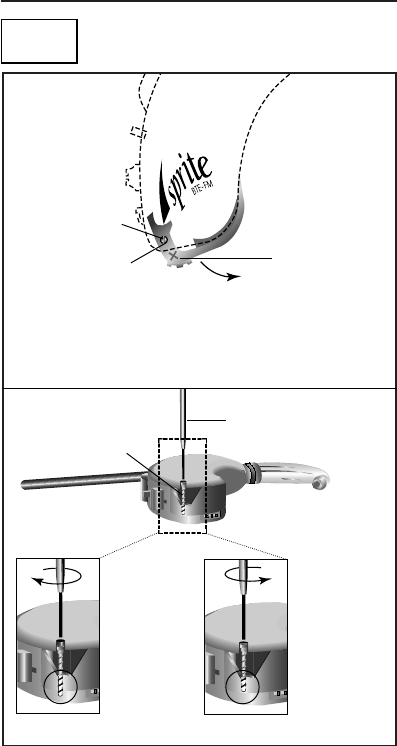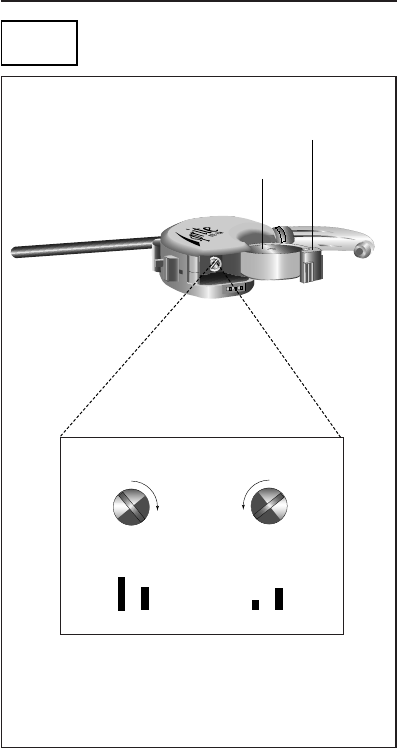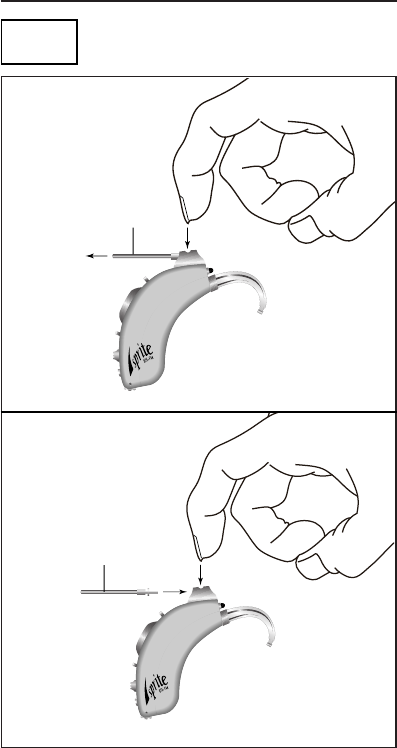Phonic Ear 300T216A Programmable hearing instrument with FM receiver User Manual 2625 Sprite User Guide Book
Phonic Ear, Inc. Programmable hearing instrument with FM receiver 2625 Sprite User Guide Book
Contents
- 1. Users manual 1
- 2. Users manual 2
Users manual 2

12
Sprite fitter instructions
To lock or unlock battery door, open door
to first detent (where the “+” sign is visible).
The locking screw should be visible through
the locking screw access hole.
AT0066 screwdriver
To unlock, turn
counter-clockwise
(about 2-3 turns)
until door opens
without catching
”+” sign
locking screw
locking hole
To lock, turn
the locking
screw clockwise
until it turns
no further
lock unlock
locking screw
locking battery door
fitter
2625 Sprite User Guide Book 10/24/01 3:05 PM Page 26

Sprite fitter instructions (cont’d)
13
FM gain control adjusts FM relative to HA gain and
has 20dB of adjustable range. It’s factory set to equal
gain. Clockwise increases FM gain, counterclockwise
decreases it.
battery door
bottom view
FM gain control
battery
setting FM gain control
FM HA
FM HA
Increases
FM gain
Decreases
FM gain
fitter
2625 Sprite User Guide Book 10/24/01 3:05 PM Page 23

14
Sprite fitter instructions (cont’d)
installing/removing antenna
to install
Depress antenna button
with fingernail and
insert antenna
antenna
to remove
Depress antenna button
with fingernail and
gently pull antenna out
antenna
fitter
2625 Sprite User Guide Book 10/24/01 3:05 PM Page 22

15
accessories
transmitter accessories
microphones
Noise-canceling behind-the-neck microphone with mute (AT0655M)
Directional lapel microphone with mic clip and lavalier cord (AT0668-L)
• Extra windscreen (AT0668-W)
• Extra clip (AT0668-C)
Omni-directional lapel microphone with mic clip and lavalier cord (AT0667-L)
• Extra windscreen (AT0667-W)
• Extra clip (AT0667-C)
Conference microphone (AT0720)
• Daisy-chaining cord (AT0721)
wearing options
Lavalier cord (AT0512)
Hip pack (AT0594)
Wire belt clip (AT0489)
Waist belt (AT0712)
miscellaneous
Wall transformer/two-unit charger (AT0534)
2 rechargeable NiCad batteries (AT0665)
Mic jack antenna (AT0529A)
AUX input patch cord – 1.5m, 4.5m/ 5ft, 15ft (AT0532)
2625 Sprite User Guide Book 10/24/01 3:05 PM Page 19

16
accessories (cont’d)
receiver accessories
earhooks
Standard (AT0596 SU)
Peak-damping (AT0596 SD)
Child’s standard (AT0597 MU)
Child’s peak-damping (AT0597 MD)
High Pass (AT0718 –High)
Low Pass (AT0718 –Low)
Notch Filter (AT0718 – Notch)
miscellaneous
Presentation bag (AT0771)
Presentation bag insert (AT0772)
Battery pack (10 pack of four 675-size) (AT0631)
T-coil cartridge (AT0754)
72MHz receiver oscillator (AT0751)
173MHz cartridge (AT0752)
216MHz cartridge (AT0753)
Blank cartridge (AT0826)
72MHz antenna
• Black (AT0750-72B)
• Green (AT0750-72G)
173MHz Antenna
• Black standard (AT0750-173B)
• Green standard (AT0750-173G)
• Black extended (AT0750-173BL)
• Green extended (AT0750-173GL)
216MHz Antenna
• Black standard (AT0750-216B)
• Green standard (AT0750-216G)
• Black extended (AT0750-216BL)
• Green extended (AT0750-216GL)
Handheld Programmer (PE 801)
• Programmer cable left (AT0748L)
• Programmer cable right (AT0748R)
NOAH Programming Cables
• NOAH cable left (AT0808L)
• NOAH cable right (AT0808R)
Screwdriver (AT0066)
Stethoset (AT0605)
2625 Sprite User Guide Book 10/24/01 3:05 PM Page 18

17
caring for your system
• Avoid contorting the antenna.
• Always dispose of old batteries in approved battery recycling bins. It may
be illegal to dispose of batteries in the trash. If you are not sure of proper
disposal method, consult your local authority.
clean your system nightly
Transmitter
Clean as needed, using a soft, damp cloth.
Hearing instrument
We recommended that you clean your hearing instrument with a soft,
damp cloth
Earmolds
Earmolds must be kept clean at all times so sound can be channeled
clearly to the ears. Disconnect the earmold and tubing from the hearing
instrument, then clean earmolds with mild soap and water only. Never
use alcohol or solvents. If the earmolds become clogged with wax, gently
push a soft, absorbent cotton pipe cleaner through the opening to clear it.
Make sure the earmold and tubing are completely dry before reconnecting
to the hearing instrument–if necessary, use a special blower available from
your hearing care professional.
storage
Temporary
When not wearing your SPRITE, keep it safely protected in its case.
Also store extra channel cartridges, screwdriver, and batteries in the
spaces provided in the case. Adhere or insert an identification tag to
the side or inside of the case.
Long-Term
Follow instructions as above, but remove the batteries before placing
the receivers into their case.
other important notes
• Protect your hearing instrument from excess humidity (shower,
bathing), heat (radiator, car in summer) and shocks. Remove hearing
instruments before using hair spray.
2625 Sprite User Guide Book 10/24/01 3:05 PM Page 15

18
code of federal regulations (United States only)
Part 21 and Part 801.420 – applies to U.S. products only
The 800R S
PRITE
BTE-FM system is hearing instrument with a built-in FM
receiver. It will not restore normal hearing, and will not prevent or improve a
hearing impairment resulting from organic conditions. Infrequent use of a
hearing instrument usually does not permit the user to attain the full benefits
of the system. Remember that this instrument is only part of the hearing
habilitation, and may need to be supplemented by auditory training and
instruction in lip reading.
Phonic Ear FM receivers and FM transmitters, when required, are approved by
the Federal Communications Commission in the U.S. and Industry Canada.
Other government approvals available upon request. (Other international regula-
tions may also apply.)
NOTE: FCC Rules, Part 15, Subpart A, 15.19 (a)(3) and (c.) This device com-
plies with part 15 of the FCC rules. Operation is subject to the following two
conditions: (1) this device may not cause harmful interference, and (2) this
device must accept any interference received, including interference that may
cause undesired operation.
Any changes or modifications made to any government-approved element of this
instrument, without the expressed approval of Phonic Ear Inc. in writing, could
void the user’s authority to operate those elements of the system.
If any changes or modifications are made it will be the responsibility of the
party performing the changes or modifications to ensure continued compliance
with the FCC regulations and they are required to: (1) File for a new equip-
ment authorization, or (2) Relabel the product(s) with “This product has been
modified by [insert the name, address and telephone number of the party per-
forming the modification].”
Part 95
This transmitter is authorized by rule under the Low Power Radio
Service (47 C.F.R. Part 95) and must not cause harmful interference to
TV reception or United States Navy SPASUR installations. You do not
need an FCC license to operate this transmitter. This transmitter may
only be used to provide: auditory assistance to persons with disabilities,
persons who require language translation, or persons in educational
settings; health care services to the ill; law enforcement tracking services
under agreement with a law enforcement agency; or automated maritime
telecommunications system (AMTS) network control communications.
Two-way voice communications and all other types of uses not men-
tioned above are expressly prohibited.
This device may not interfere with TV reception or federal government
radar, and must accept any interference received, including interference
that may cause undesired operation.
2625 Sprite User Guide Book 10/24/01 3:05 PM Page 14

19
code of federal regulations (cont’d)
warning to hearing aid dispensers
A hearing aid dispenser should advise a prospective hearing instrument user
to consult with a licensed physician (preferably an ear specialist) before
dispensing a hearing instrument if the hearing aid dispenser determined
through inquiry, actual observation, or review of any other available informa-
tion concerning the prospective user, that the prospective user has any of the
following conditions:
1Visible congenital or traumatic deformity of the ear.
2History of active drainage from the ear within the previous 90 days.
3History of sudden or rapidly progressive hearing loss within the previous 90 days.
4Acute or chronic dizziness.
5Unilateral hearing loss of a sudden or recent onset within the previous 90 days.
6Audiometric air bone gap equal to or greater than 15 decibels at 500 hertz
(Hz), 1,000 Hz, and 2,000 Hz.
7Visible evidence of significant cerumen (ear wax) accumulation or a foreign
body in the ear canal.
8Pain or discomfort in the ear.
important notice for prospective hearing instrument users
Good health practice requires that a person with a hearing loss have a med-
ical evaluation by a licensed physician (preferably a physician who specializes
in diseases of the ear) before purchasing a hearing instrument. Licensed
physicians who specialize in diseases of the ear are often referred to as
otolaryngologists, otologists, or otorhinolaryngologists. The purpose of a
medical evaluation is to assure that all medically treated conditions that
may affect hearing are identified and treated before a unit is purchased.
Following the medical evaluation, the physician should give you a written
statement which states your hearing loss has been medically evaluated,
and that you may be considered a candidate for a hearing instrument.
The physician should refer you to an audiologist or hearing aid dispenser,
as appropriate, for a hearing instrument evaluation.
The audiologist or hearing aid dispenser will conduct a hearing instrument
evaluation to assess your ability to hear with and without a hearing instru-
ment. The evaluation will enable the audiologist or dispenser to select and
fit a unit best suited to your individual needs.
If you should have reservations about your ability to adapt to amplification,
you should inquire about the availability of a trial rental or purchase-option
program. Many dispensers now offer programs that permit you to wear the
hearing instrument for a period of time for a nominal fee after which you
may decide if you want to purchase that unit.
Federal law restricts the sale of hearing instruments to those individuals who have
not obtained a medical evaluation from a licensed physician. Federal law permits
a fully informed adult to sign a waiver statement declining the medical
evaluation for religious or personal beliefs that preclude consultation with
a physician. The exercise of such a waiver is not in your best interest and
its use is strongly discouraged.
2625 Sprite User Guide Book 10/24/01 3:05 PM Page 11

20
warranty
A one-year limited warranty is issued to the original consumer of the product(s)
by Phonic Ear Inc.
U.S./International Canada
Sales and Service Sales and Service
Phonic Ear Inc. Phonic Ear Ltd.
3880 Cypress Drive 10-7475 Kimbel Street
Petaluma, CA 94954-7600 Mississauga, Ontario
U.S.A. L5S 1E7 Canada
800.227.0735 800.263.8700
707.769.1110 905.677.3231
707.769.9624 FAX 905.677.7760 FAX
time period of warranty
This warranty will go into effect upon the date of original purchase of this
equipment, and will remain in effect for one calendar year from that date as
long as the instrument remains the property of the original consumer.
what is covered by this warranty
Any electronic component which, because of workmanship, manufacturing, or
design defects, fails to function properly under normal use during the life of this
warranty will be replaced or repaired at no charge for parts or labor when
returned to the factory service center. Transportation in is paid by the customer.
If it is determined that repair is not feasible, the entire unit may be replaced with
an equivalent unit upon mutual agreement of the manufacturer and customer.
what is not covered by this warranty
This one-year limited warranty does not apply to:
1Malfunctions resulting from abuse, neglect, or accident.
2Peripheral accessories as itemized within the product brochure, when
such items are returned after 90 days from the original purchase.
3Alkaline batteries, if applicable.
4Instruments connected, installed, used, or adjusted in a manner contrary
to instructions provided by the manufacturer.
5Consequential damages and damages resulting from delay or loss of
this instrument. The exclusive remedy under this warranty is strictly
limited to repair or replacement as herein provided.
6Products damaged in transit, unless investigated by the shipper and
returned to the warrantor with the investigation report.
Phonic Ear Inc. reserves the right to make changes in the design or construction
of any of its instruments at any time without incurring any obligation to make
any changes whatsoever on units previously purchased. This warranty is in lieu
of all other expressed warranties. All expressed and implied warranties will ter-
minate upon the expiration of this written warranty. No representative or person
is authorized to represent or assume for us any liability in connection with the
sale or use of our products other than as set forth above.
what to do if you need service
If you require service under the terms of this warranty, carefully package the
instrument to prevent damage in transit and send it postpaid to the nearest factory
service center. In your package, include the following: a detailed description of the
problem, your full name, billing and shipping address and telephone number.
2625 Sprite User Guide Book 10/24/01 3:05 PM Page 10

21
troubleshooting
(refer to previous pages for explanatory diagrams)
no FM reception
cause solution
• Transmitter is not turned on • Check that the transmitter is on
• Transmitter and SPRITE are not • Verify that the SPRITE channel selector
set to the same channel is set to the same channel as the receiver
• Mode switch is set incorrectly • Set the mode switch to M/F or F
•SPRITE volume setting is too low • Check the SPRITE volume control setting
•S
PRITE antenna is not attached
• Verify that the
SPRITE
antenna is attached
• Worn-down batteries
• Recharge or replace the transmitter’s batteries
• No sound entering microphone
• Verify that the microphone is working
(Test with another working microphone)
• Replace S
PRITE
battery
transmitter batteries won’t charge
cause solution
• No power from wall transformer • Verify that the wall transformer is
plugged into a working wall outlet
• Check the charge connections to
the transmitter(s)
• Charge cord not attached properly • Try a different wall transformer
• Verify that the CHARGE LED on the
transmitter lights when the charge cord
is plugged in
• Transmitter is turned ON • Check that the transmitter is turned
while charging OFF before charging
• Check that the batteries are NiCad
(DO NOT charge alkaline)
2625 Sprite User Guide Book 10/24/01 3:05 PM Page 7

22
troubleshooting (cont’d)
whistling or squealing noise
cause solution
• Ear wax accumulated in ear canal • Have ear canal examined by your doctor
• Earmolds inserted improperly • Reinsert earmolds
• Split or damaged tubing • Replace the tubing
no sound
cause solution
• Clogged earmolds • Clean earmolds
• Exhausted batteries • Replace batteries
• Instrument switched to • Switch to M, M/F, or M/T model
telecoil or FM
• Instrument switched OFF • Close battery door
• Dirty or corroded battery contacts • Open and close the battery drawer
several times or replace battery
whirring noise, ”motorboating”, or fading
weak sound
cause solution
• Dirty or corroded battery contacts • Open and close the battery drawer
several times or replace battery
• Dirty or corroded batteries • Clean battery surfaces with dry
cloth or replace battery
• Worn-down batteries • Replace battery
2625 Sprite User Guide Book 10/24/01 3:05 PM Page 6

23
other important information
audiological evaluation of hearing loss in children
In addition to seeing a physician for a medical evaluation, a child with
hearing loss should be directed to an audiologist because hearing loss
may hinder language development and educational and social growth.
An audiologist is uniquely qualified by training and experience to assist
in evaluation and therapy for a child with a hearing loss.
possible side effects
The tan SPRITE BTE-FM case is made of ABS Novadur plastic, and the
clear SPRITE BTE-FM case is made of Cellidor CP 400-10. There are few
known side effects caused by these materials; however, should a rash develop
in an area of direct contact with the skin, or if you experience an accelerated
accumulation of cerumen (ear wax), consult your physician.
caution
Hearing instruments and batteries can be dangerous if swallowed or used
improperly. Such actions can result in severe injury, permanent hearing
loss, or even death.
You should familiarize yourself fully with the following general warnings
and the entire contents of this guide before using your hearing instruments.
• Hearing instruments should be used only as directed and adjusted by your
hearing health care professional. Misuse can result in sudden and perma-
nent damage to the remaining hearing of the user.
• Hearing instruments, their parts, and batteries are not toys and should be
kept out of reach of anyone who might swallow these items or otherwise
cause themselves injury.
• Never change the battery or adjust the controls of the hearing instruments
in front of infants, small children, or persons of mental incapacity.
• Discard batteries carefully in a place where they cannot be reached by
infants, small children, or persons of mental incapacity.
• Always check medication before swallowing, as batteries have been
mistaken for pills.
• Never put your hearing instruments or batteries in your mouth for any
reason, as they are slippery and could be swallowed.
• Never allow others to wear your hearing instruments, as they could be
misused and permanently damage another’s hearing.
• Hearing instruments may stop functioning suddenly if the batteries are
low. You should be aware of this possibility, in particular when you are in
traffic or otherwise dependent on warning sounds.
• Always use batteries recommended by your hearing health care professional.
Batteries of low quality may leak and cause bodily injury.
If a battery or hearing instrument part is swallowed, see a doctor immediately.
2625 Sprite User Guide Book 10/24/01 3:05 PM Page 3

© 2001 Phonic Ear Inc. 821-7304-101/Rev. B/2625 0801
us: 800.227.0735, then press 5 • canada: 800.263.8700
outside u.s./canada: Call your local Phonic Ear dealer
website: www.phonicear.com
2625 Sprite User Guide Book 10/24/01 3:04 PM Page 1